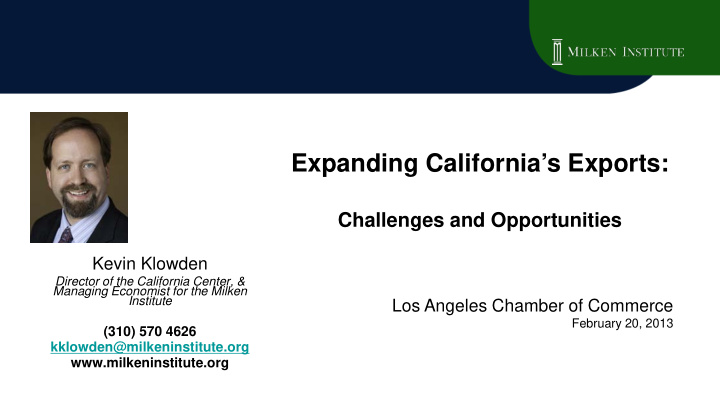



California Economic Overview Expanding California’s Exports: Challenges and Opportunities Kevin Klowden Director of the California Center, & Managing Economist for the Milken Institute Los Angeles Chamber of Commerce February 20, 2013 (310) 570 4626 kklowden@milkeninstitute.org www.milkeninstitute.org
Export growth in select states 1998 - 2012 State Percent growth UNITED STATES 150% Texas 236% Alabama 206% Florida 172% Pennsylvania 143% California 69% Source: International Trade Administration.
Export promotion efforts in California have been fragmented Part 1 • 1960: first foreign trade offices established in London and Frankfurt. • 1967: offices closed due to a budget crisis. • 1977: the Department of Economics and Business is created (later becomes the Department of Commerce. • 1982: the World Trade Commission is established, has mandate to promote trade and investment. • 1983: the Department of Food and Agriculture and the California Energy Commission set up programs to support trade in their respective sectors. Source: California Trade and Commerce Agency Report.
Export promotion efforts in California have been fragmented Part 2 • 1987: Office of Export Development is created with two foreign trade offices in London and Tokyo. • 1993: the World Trade Commission, Department of Commerce and all existing foreign trade offices are merged into a new agency, the California Technology Trade and Commerce Agency. • 1993 to 2003: additional foreign trade offices are created (at one point there were 15 in operation). • 2003: the California Technology Trade and Commerce Agency is shut down, including all existing foreign trade offices. • 2012: Gov. Brown announces a trade office will be opened in China. Source: California Trade and Commerce Agency Report.
California exports Q1 2008 – Q4 2012 Source: WISERTrade.
Export growth 1998 - 2012 Source: International Trade Administration.
Export growth 1998 - 2012 Source: International Trade Administration.
California exports showing 2012 decline Q1 2008 – Q4 2012 Source: WISERTrade.
California exports to select markets Q1 2008 – Q4 2012 Source: WISERTrade.
Texas exports to select markets Q1 2008 – Q4 2012 Source: WISERTrade.
California exports by market proportion 2012 Source: International Trade Administration. Note: Latin America includes the Caribbean, Other Asia is the Asian continent excluding the Middle East
California exports by industry 2012 Source: International Trade Administration.
Exports by industry 1998 & 2012 (percent of total exports) Source: International Trade Administration.
Cargo traffic in California (major cargo airports) Metric tons (000’s) Airport 2012 2005 % Change LAX 1,963 2,137 -8.1% OAK 499 671 -25.6% ONT 455 533 -14.6% SFO 381 590 -35.5% Sources: Airports Council International, San Francisco International Airport, Oakland International Airport, Los Angeles World Airports. Note: Hong Kong International Airport and Memphis International Airport are the 1 st and 2 nd ranked cargo airports in the world, both with just over 4 million tons of cargo transported in 2012.
Cargo traffic in California (major seaports) Twenty-foot equivalent unit (millions) Seaport 2012 2005 % Change Los Angeles 7.94 7.50 5.9% Long Beach 6.06 6.71 -9.7% Oakland 2.34 2.27 3.0% Sources: American Association of Port Authorities, Port of Long Beach, Port of Los Angeles, Port of Oakland. Note: Los Angeles and Long Beach are the 1 st and 2 nd ranked ports in the country.
Indexed export growth of best practice states Relative to national average (1998 - 2012) Source: International Trade Administration.
Florida export promotion • Florida has a decentralized export-promotion strategy • Enterprise Florida (EFI) – the main economic development agency – coordinates promotion activities • EFI is a public-private partnership that operates in conjunction with a statewide network of economic development agencies • Enterprise Florida runs twelve foreign trade offices and seven in-state offices Source: Enterprise Florida.
Florida export promotion • The Florida Trade Partners Alliance (FTPA) is a statewide group consisting of twenty-three organizations, each involved in the export industry in Florida • It was formed in 1997 by Enterprise Florida and the U.S. Export Assistance Centers of Florida, and it is unique in the country • The alliance provides assistance through a wide group of programs offered by its member organizations • What makes the organization effective is that all of the participating groups contribute funding to support the group Source: Enterprise Florida.
Massachusetts export promotion • In 2010, the Massachusetts Technology Collaborative (a public economic development agency) released a detailed international strategy for the state • Governor Patrick reinstated the Massachusetts Office of International Trade and Investment (MOITI) • The report outlines how MOITI can bring together Massachusetts’ export assets in a coordinated manner • The report points to local advantages that can help the state improve its export base and suggests small support programs (such as grants to SMEs) aimed at improving involvement in international activities Source: Massachusetts Technology Collaborative.
Alabama export promotion • The Alabama Development Office (ADO) runs the state’s export promotion • The agency’s international trade office helps businesses through statewide professional trade-development programs • The ADO’s services are free, and the organization limits the scope of its activities by focusing on specific industry sectors. It chooses its sectors based on growth and potential • The Export Alabama Alliance is another key player. It is a network of trade agencies within Alabama, which provides coordinated assistance to companies Source: Alabama Development Office.
Pennyslvania export promotion • In 2005, the Center for Trade and Development (CTD) in Pennsylvania instituted a detailed goal-assessment system to track the effectiveness of its export promotion initiatives • The CTD sets the level it expects to achieve, and each partner is encouraged to meet these targets • The targets are unique to each partner and based on the level of funding or grant assistance they receive from the CTD • The CTD can evaluate, very precisely, areas of weakness and determine which partners are not achieving the goals, and on which measurements Source: Pennsylvania Center for Trade and Development
Recommend
More recommend